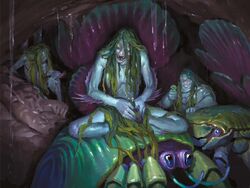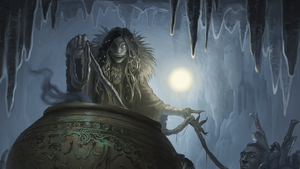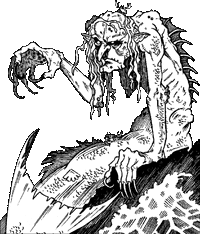Sea hags were the most repulsive and wretched of hags and were prideful in their gruesome appearance.[7] The wicked fey lived near or within large bodies of water and the unfortunate souls that set eyes on them were often feasted on shortly after.[3][8]
Description[]

A coven of three hags in Undermountain.
Hags were universally hideous beings, but even by the unbelievably low standards applied to their race, sea hags were abysmally grotesque. Despite their penchant for devouring their victims they had an emaciated appearance,[1][3] although they could be of varying height and big-boned as opposed to scraggly.[8] Befitting their haggard nature, their flesh was also rife with warts and oozing cankers.[2][3]
Their complexion was like that of a rotting fish:[8] pallid yellow skin with patches of green, slimy scales and bony protrusions.[1][3] Their piscine eyes were similarly devoid of life with deep,[1] black pupils surrounded by red.[3]
The weak-hearted were known to die upon gazing at sea hags, but fortunately they had long, limp, hair that resembled rancid seaweed, which often concealed their true forms.[2][3] Even without their squalid manes, sea hags could use illusory magic to disguise their appearance, although whatever form they took, they were cursed (or perhaps in their opinion, blessed) to appear ugly.[1]
Personality[]
While all hags possessed an inverted sense of beauty, seeing it as ugly and vice versa, sea hags in particular were known for utterly abhorring all that was attractive. Many were filled with fury upon the sight of something beautiful and swiftly attempted to break it, but were more likely to take a corruptive approach to expressing their outrage. Rather than simply destroy the inspiring they would defile it so as to reverse its intended effect, turning symbols of hope into figures of despair, icons of courage into images of dread and places of joy into dens of misery.[1][8]
Sea hags themselves normally lived as gloomy recluses, in lairs as dismal as they were. As they watched others go about their lives, they began slowly bubbling with jealous rage until their hatred overflowed and they were compelled to release it. Sometimes wanderers would intrude upon their domains and give them a chance to vent, but they would just as easily exit their homes and hunt for victims, whether among the surface-dwellers or other aquatic entities.[9]
Abilities[]
A sea hag's greatest weapon was the sheer atrocity that was their appearance, for just looking upon a sea hag could inspire fright so overwhelming that it sapped strength.[3] Even worse than laying eyes upon a sea hag was when a sea hag laid eyes on someone else, for their evil eye could have dire effects on those they glared at. If already horrified,[1] victims were at risk of, if not outright death, then paralysis or a simple dazed state, for several days.[2][3] While they could use their illusory disguise to avoid detection, it was only visual in nature and failed to hold up under close scrutiny.[1][3]
Combat[]
When fighting, sea hags lacked subtle tactics beyond a simple ambush. They would hide or disguise themselves in an attempt to lure as many of their potential prey close before revealing themselves.[2][3] Whenever possible, sea hags used their horrific glare to render foes helpless and would consume the fallen victims as soon as possible.[3] Melee was considered a secondary tactic only to be used if the enemy was outnumbered and despite their claws they were known to prefer using daggers.[2][3] When undergoing ordinary forms of training they often became fighters or barbarians, otherwise becoming clerics.[7]
Society[]

The lake hag Maud Chiselbone and her will-o'-wisp companion making human stew.
Sea hags were known to be solitary beings. They typically laired in bleak and befouled areas surrounded by underwater monsters and with nearby settlements. The verticality of their homes was generally irrelevant; they might inhabit sunken shipwrecks, polluted shores or slopes and cliffsides.[8][9]
Around the lairs of powerful sea hags, such as grandmas or aunties, could have noticeable signs of their presence. Such indicators could be treacherous tides, a slick, slippery film of slime coating most surfaces, or an abundance of decaying fish corpses that the sea hag could speak through and sense the disturbance of. Within their lairs such hags would be even more dangerous, gaining abilities such as the power to create splotches of murky ink within it or the ability to create obedient simulacrums out of ooze, kelp, fish corpses and nebulous debris based on anyone inside the lair.[8]
Religion[]
Some sea hags venerated Dagon as a deity.[10]
Language[]
Sea hags had their own language and spoke the language of annis hags.[3] They also often knew Common, Aquan, Giant[1] and the aquatic variant of Elven.[3]
Ecology[]
Sea hags, appropriately, were known to occupy warm seas in shallows with overgrown vegetation.[3] They were amphibious and swam faster than they walked.[1]
Sea hags were said to have a maximum lifespan of approximately 800 years old, if not several millennia.[3][8]
Locations[]
Sea hags could be found in the Sea of Fallen Stars, typically swimming at a depth between 150‒300 ft (46‒91 m).[9] Within the underwater caves of Skullport, sea hags dwelt in the husks of lost ships.[11]
Subraces[]
While less common and less magically resistant than their marine cousins, there existed a breed of freshwater sea hags. They made their homes in non-arctic bodies of water such as lakes but needed more light.[3][12]

A greater sea hag
There also existed a race of greater sea hags that, like freshwater sea hags, were far more rare. Some were indistinguishable from ordinary sea hags while others were larger, had greater charisma or possessed piscine lower halves. They were just as envious and suspicious as their ordinary kin and so rarely joined covens or reproduced, but often lived 200 years longer than they did.[13]
They were just as hideous as their ordinary kin but their gaze served to enchant prey rather than kill them. They would take on the appearance of attractive beings like merfolk or nereids before luring ships into dangerous waters, causing the ship to sink. Afterwards, they would steal the treasures on board and devour the crew, adding flesh to their diet of grounded rock salt. They also possessed greater innate, magical ability and a rare few had psionic powers.[13]
Rumors and Legends[]
Ogre and hill giant myths told that the moon goddess Cegilune was the mother of the hag race and that sea hags were among the original types to have been wrought from her former worshipers.[14] However, some believed that greater sea hags were the descendants of more powerful beings created by the wicked Elemental Evil Princess of Elemental Water, Olhydra. The Princess, in turn, argued that lesser sea hags and possibly all hags were really the degenerate spawn of the superior, greater sea hags.[13]
Notable Sea hags[]
- Caldra Cuttlefingers, Coral Black and Gurgle Brine were a coven of hags who dwelled in the Sargauth Level of Undermountain.
- Magglerak was a sea hag who was part of a coven of with an annis and green hag in Cormanthyr.[15]
- Myldryd Urchinspine, who laired within the wreckage of the Dirty Dastard on the Snout of Omgar.[16]
- Olive Stillwater was a sea hag running a run-down shop in Skullport. Disguised as a crone covered in snails and barnacles, she sold zombies for small bits of blood and hair she would ingest in order to cast animate dead.[11]
Appendix[]
Appearances[]
Adventures
Novels & Short Stories
The Council of Blades • City of Torment • Honor Among Thieves: The Road to Neverwinter
Video Games
Baldur's Gate III
Card Games
Miniatures
Organized Play & Licensed Adventures
Gallery[]
References[]
- ↑ 1.00 1.01 1.02 1.03 1.04 1.05 1.06 1.07 1.08 1.09 1.10 1.11 1.12 Mike Mearls, Jeremy Crawford, Christopher Perkins (2014-09-30). Monster Manual 5th edition. Edited by Scott Fitzgerald Gray. (Wizards of the Coast), p. 179. ISBN 978-0786965614.
- ↑ 2.0 2.1 2.2 2.3 2.4 2.5 2.6 2.7 2.8 2.9 Skip Williams, Jonathan Tweet, Monte Cook (July 2003). Monster Manual v.3.5. (Wizards of the Coast), p. 144. ISBN 0-7869-2893-X.
- ↑ 3.00 3.01 3.02 3.03 3.04 3.05 3.06 3.07 3.08 3.09 3.10 3.11 3.12 3.13 3.14 3.15 3.16 3.17 3.18 Doug Stewart (June 1993). Monstrous Manual. (TSR, Inc), pp. 181–182. ISBN 1-5607-6619-0.
- ↑ Gary Gygax (December 1977). Monster Manual, 1st edition. (TSR, Inc), p. 86. ISBN 0-935696-00-8.
- ↑ Skip Williams, Jonathan Tweet, Monte Cook (July 2003). Monster Manual v.3.5. (Wizards of the Coast), p. 311. ISBN 0-7869-2893-X.
- ↑ Skip Williams, Jonathan Tweet, Monte Cook (July 2003). Monster Manual v.3.5. (Wizards of the Coast), p. 143. ISBN 0-7869-2893-X.
- ↑ 7.0 7.1 Jennifer Clarke Wilkes, David Eckelberry, Rich Redman (February 2003). Savage Species. (Wizards of the Coast), p. 193. ISBN 0-7869-2648-1.
- ↑ 8.0 8.1 8.2 8.3 8.4 8.5 8.6 Mike Mearls, et al. (November 2016). Volo's Guide to Monsters. Edited by Jeremy Crawford, et al. (Wizards of the Coast), pp. 52–62. ISBN 978-0786966011.
- ↑ 9.0 9.1 9.2 Steven E. Schend (1999). Sea of Fallen Stars. (TSR, Inc), p. 39.44. ISBN 0-7869-1393-2.
- ↑ James Jacobs (November 2006). “The Demonomicon of Iggwilv: Dagon: Prince of Darkened Depths”. In Erik Mona ed. Dragon #349 (Paizo Publishing, LLC), pp. 35–36.
- ↑ 11.0 11.1 Christopher Perkins (November 2018). Waterdeep: Dungeon of the Mad Mage. Edited by Jeremy Crawford. (Wizards of the Coast), p. 49.303.306. ISBN 978-0-7869-6626-4.
- ↑ Mark S. Harcourt (December 1982). “What's in the Water?”. In Kim Mohan ed. Dragon #68 (TSR, Inc.), p. 40.
- ↑ 13.0 13.1 13.2 Ed Greenwood (October 1998). The City of Ravens Bluff. Edited by John D. Rateliff. (TSR, Inc.), p. 96. ISBN 0-7869-1195-6.
- ↑ F. Wesley Schneider (July 2006). “The Ecology of the Annis”. In Erik Mona ed. Dragon #345 (Paizo Publishing, LLC), pp. 64–66.
- ↑ Jeff Fairbourn (May/June 1991). “Nymph's Reward”. In Barbara G. Young ed. Dungeon #29 (TSR, Inc.) (29)., pp. 8–24.
- ↑ Christopher Perkins, Jeremy Crawford (September 2017). The Tortle Package. (Wizards of the Coast), p. 19.

